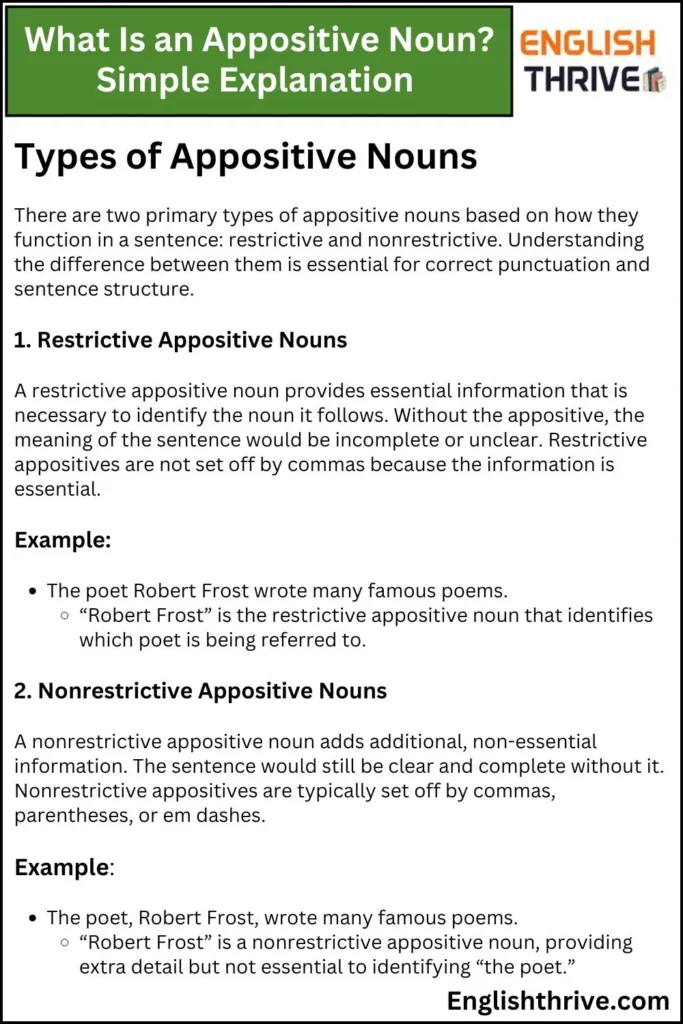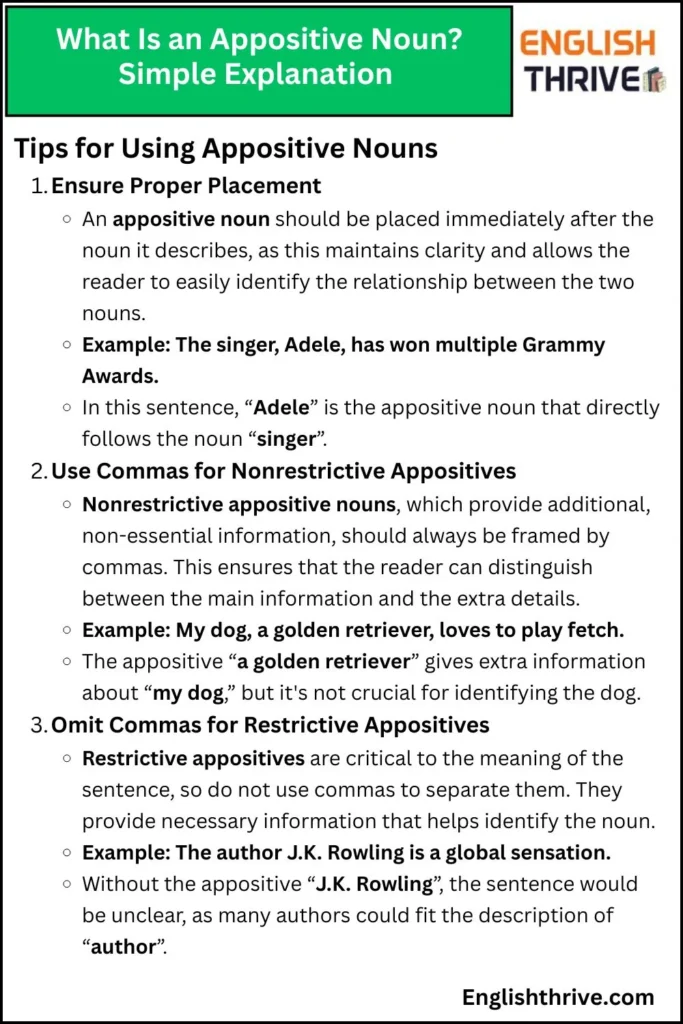An appositive noun is an essential component of sentence structure in English grammar. It serves to provide additional information or clarification about a noun by placing another noun or noun phrase directly next to it. This practice enhances writing by allowing more detailed descriptions without overcomplicating the sentence.
In this article, we will explore what an appositive noun is, how it functions within a sentence, and the different ways it can be used. Whether you’re a student of English or simply refining your writing skills, understanding appositives will help you add depth and precision to your work.
Contents
ToggleWhat Is an Appositive Noun?
At its core, an appositive noun is a noun or noun phrase that immediately follows another noun in a sentence. The appositive provides additional details that further define or identify the noun it follows. The key point here is that the appositive helps clarify or add information, which is why it’s often referred to as a “bonus” piece of information.
Example:
Harry Potter, the famous wizard, defeated Voldemort.
“the famous wizard” is the appositive noun, providing additional information about Harry Potter.
How Does an Appositive Work?
The function of an appositive noun is to define, clarify, or explain the noun it follows. The important thing to remember is that it provides more specific information that either renames or elaborates on the noun it’s associated with.
Here are the components of a typical sentence with an appositive:
Noun (Antecedent): The noun that the appositive will describe.
Appositive: The noun or noun phrase that provides additional information about the noun.
Punctuation: Appositive nouns can be nonrestrictive (set off with commas) or restrictive (no commas).

Types of Appositive Nouns
There are two primary types of appositive nouns based on how they function in a sentence: restrictive and nonrestrictive. Understanding the difference between them is essential for correct punctuation and sentence structure.
1. Restrictive Appositive Nouns
A restrictive appositive noun provides essential information that is necessary to identify the noun it follows. Without the appositive, the meaning of the sentence would be incomplete or unclear. Restrictive appositives are not set off by commas because the information is essential.
Example:
The poet Robert Frost wrote many famous poems.
“Robert Frost” is the restrictive appositive noun that identifies which poet is being referred to.
2. Nonrestrictive Appositive Nouns
A nonrestrictive appositive noun adds additional, non-essential information. The sentence would still be clear and complete without it. Nonrestrictive appositives are typically set off by commas, parentheses, or em dashes.
Example:
The poet, Robert Frost, wrote many famous poems.
“Robert Frost” is a nonrestrictive appositive noun, providing extra detail but not essential to identifying “the poet.”
How to Punctuate Appositive Nouns
The punctuation of appositive nouns depends on whether they are restrictive or nonrestrictive. Correct punctuation ensures that your writing is clear and that readers can easily distinguish between essential and non-essential information.
1. Commas for Nonrestrictive Appositives
Use commas to set off nonrestrictive appositive nouns. These are appositive phrases that provide extra, but non-essential, details.
Example:
My car, a red Toyota, is parked outside.
“A red Toyota” is nonessential; it gives extra information but is not crucial to identifying “my car”.
2. No Commas for Restrictive Appositives
Restrictive appositive nouns do not get set off by commas because the information is necessary to the meaning of the sentence.
Example:
The novel To Kill a Mockingbird is a classic.
“To Kill a Mockingbird” is essential in identifying the novel.
Examples of Appositive Nouns in Sentences
To better understand appositive nouns, let’s look at several examples that illustrate how appositives work in context.
Nonrestrictive Appositive Example:
The artist, Leonardo da Vinci, is known for painting the Mona Lisa.
Here, “Leonardo da Vinci” adds extra information about “the artist”. Without it, the sentence still makes sense.
Restrictive Appositive Example:
My brother James is visiting this weekend.
“James” is essential to identifying “my brother”. Without it, we wouldn’t know which brother is being referred to.
Complex Appositive Example:
The famous playwright, Shakespeare, wrote many works that are still performed today.
The appositive “Shakespeare” helps clarify which “playwright” is being referred to.
Why Use Appositive Nouns?
Using appositive nouns in writing helps enhance clarity and add detail without the need for excessive adjectives or descriptive phrases. By placing additional information directly after the noun, writers can streamline their sentences and avoid repetition while still providing the necessary context.

Tips for Using Appositive Nouns
Ensure Proper Placement
An appositive noun should be placed immediately after the noun it describes, as this maintains clarity and allows the reader to easily identify the relationship between the two nouns.
Example: The singer, Adele, has won multiple Grammy Awards.
In this sentence, “Adele” is the appositive noun that directly follows the noun “singer”.
Use Commas for Nonrestrictive Appositives
Nonrestrictive appositive nouns, which provide additional, non-essential information, should always be framed by commas. This ensures that the reader can distinguish between the main information and the extra details.
Example: My dog, a golden retriever, loves to play fetch.
The appositive “a golden retriever” gives extra information about “my dog,” but it’s not crucial for identifying the dog.
Omit Commas for Restrictive Appositives
Restrictive appositives are critical to the meaning of the sentence, so do not use commas to separate them. They provide necessary information that helps identify the noun.
Example: The author J.K. Rowling is a global sensation.
Without the appositive “J.K. Rowling”, the sentence would be unclear, as many authors could fit the description of “author”.
Avoid Overusing Appositives
While appositive nouns add value to your writing, using them excessively can make sentences feel cumbersome or overly detailed. Use them sparingly for maximum effect.
Example: Correct use: The teacher, Mrs. Smith, was very kind.
Overuse: The teacher, Mrs. Smith, a kind woman, who loves her students, was very kind.
In the overuse example, too many appositives clutter the sentence and take away from its simplicity.
Use Appositive Nouns for Emphasis
Appositives can also be used for emphasis, especially when they’re placed at the end of a sentence. This technique can help highlight important information.
Example: She has always been the one to offer help: Mary, the most generous person I know.
Here, “Mary” is emphasized by placing her name at the end of the sentence, giving extra weight to the appositive.
Common Mistakes to Avoid with Appositive Nouns
Understanding common mistakes and how to avoid them is crucial when working with appositive nouns. Here are a few pitfalls to be mindful of:
Misplacing Commas
Using commas incorrectly can change the meaning of a sentence. For example:
Incorrect: My car a red Toyota, was parked outside.
Correct: My car, a red Toyota, was parked outside.
The first example without commas makes the sentence hard to read and could be confusing. The correct sentence clearly separates the appositive from the main clause.
Using Appositive Nouns When They’re Unnecessary
Sometimes, appositive nouns are used when they aren’t needed, adding unnecessary complexity. If the noun is already clearly identified, there’s no need for an appositive.
Example: Incorrect: The dog, Max, was barking loudly.
In this case, if we already know the dog’s name is Max, the appositive is redundant. It could simply be: The dog was barking loudly.
Confusing Restrictive and Nonrestrictive Appositives
One of the most common errors is using commas with restrictive appositives or omitting commas with nonrestrictive appositives.
Example: Incorrect: My friend Bill, loves pizza.
Correct: My friend Bill loves pizza. (No commas are needed because Bill is essential to the sentence.)
Benefits of Using Appositive Nouns in Writing
Using appositive nouns strategically can significantly improve your writing. Here are some of the key benefits:
Clarity and Precision
Appositives provide essential details that help the reader understand exactly what you mean. This improves the overall clarity of your writing.
Conciseness
Rather than writing lengthy explanations, an appositive noun allows you to present extra details in a compact, effective way.
Enhanced Sentence Structure
When used correctly, appositives can add variety to sentence structure. They can break up longer sentences and prevent monotony, making your writing more engaging.
Improved Reader Engagement
Appositives keep the writing engaging by providing context and background information without losing the flow of the sentence.
FAQs on Appositive Nouns
What is an appositive noun?
An appositive noun gives extra information about another noun.
Example: My friend, John, loves music.
What’s the difference between restrictive and nonrestrictive appositives?
Restrictive appositives are essential to the meaning and don’t use commas.
Nonrestrictive appositives add extra detail and are set off with commas.
How do you punctuate appositives?
Use commas for nonrestrictive appositives.
Example: My dog, a golden retriever, is playful.
Can appositives come at the end of a sentence?
Yes, they can appear at the end for emphasis.
Example: She met her idol—Emma Watson, the actress.
Why are appositives important?
They make writing clear, detailed, and concise by adding quick, helpful information about nouns.
Conclusion: Mastering Appositive Nouns
In conclusion, appositive nouns are a powerful tool in English grammar. They allow you to add detail, clarification, and emphasis to your writing without making the sentence overly complex. By understanding the difference between restrictive and nonrestrictive appositives and using the correct punctuation, you can significantly improve your writing.
Mastering appositive nouns will help you create more dynamic and descriptive sentences that captivate your readers. Keep practicing, and soon using appositive nouns will become a seamless part of your writing process.

